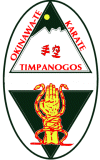
Okinawa-Te is a very old discipline, but rather than causing it to be overly formal and rigid, just the opposite is true. Okinawa-Te is a very practical and straightforward system. It was created in an environment where only results mattered, and it shows that in everything about it. It was also created in an environment where secrecy was essential so while there is always a simple explanation for everything, that is rarely all that there is.
Students of Okinawa-Te continually find themselves discovering new things in technique that they had previously learned. If they look deeply they find that in the kata there is rarely only one explanation for a given move. If they examine things closely they will find that there are nearly always two or three explanations for each move and in some places they can find a near infinite number of explanations.
The Basics, the first things taught to new students are the fundamentals to everything. The basics in Okinawa-Te cover the standard blocks, punches, kicks, and defenses. Using only technique that is taught in the first two color belts a student could defend themselves fairly well against the vast majority of opponents. The crucial thing about basics is that they continue to be refined and improved as more advanced technique is learned. A back kick done by a beginner is different from that done by an intermediate student, and is even more different from one done by an advanced student. Some technique is not truly understood until it has been done ten thousand times.
Kata is the encyclopedia of our system. Contained in the kata are all the important moves and combinations of moves in the system. For this reason Okinawa-Te kata is not a simple stringing together of standard moves, as in some other schools. In Okinawa-Te, kata is where the more advanced and difficult technique is taught. It is taught in the context of usage, because advanced technique divorced from context is frequently meaningless.
In Okinawa-Te we do not prefer one part of the body, or one mode of attack or defense over another. Every part of the body can function as both offensive and defensive weapons and should be used. We practice kicking at all levels. We practice striking at all levels. We practice throws, sweeps, trips and other takedowns. We practice defense from standing and from the ground. We work to find the technique which works best for every individual. Technique which works well for a person of one body type is not nearly as effective for a person of a different body type. Technique must be adjusted both for the practitioner as well as for the opponent.
Rank is irrelevant outside one's own school. Within one's school, rank is only a measure of the quantity of technique you are responsible for having begun to master. Fighting ability has nothing to do with rank. A new student with speed, youth, and natural athletic talent can sometimes triumph over a student who has studied long and lacks those attributes. Talent is a natural gift over which we have no control. A naturally gifted student can progress more rapidly than a less gifted one if they both work equally hard. A student who is both talented and a hard worker can gain proficiency very quickly, but this happens only rarely.
Whether a person possesses a Black belt or not tells you nothing as to their talent or ability. In Okinawa-Te a Black belt takes much longer to obtain than in most other schools, but most students of Okinawa-Te care little for rank or when or whether they achieve a Black Belt. Too many students in other schools believe that the Black belt has meaning in and of itself. They are mistaken.
What belts and tests really mean
